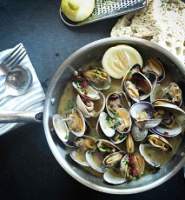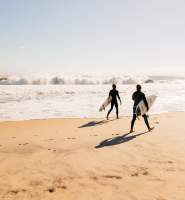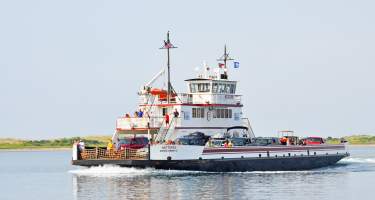Hatteras Village, NC
Hanging on the southern tip of Hatteras Island, Hatteras Village has a well-earned reputation as an epicenter for fishing. Generations of families have operated fish houses, ocean-going and Pamlico Sound commercial fleets, and have turned to fishing as a primary pastime. This holds true today, so much so it’s odd to see a local or visitor without a rod, tacklebox, or just-caught fish in hand.
While that’s an exaggeration, it’s not far off. In Hatteras Village – which has gone by no other name, a rarity on the Island – life has always focused on the water. Families tended toward a few careers: fishing, boatbuilding, and the U.S Lifesaving Service (which later became the US Coast Guard). Several commercial marinas and charter fishing docks keep the fishing traditions alive, and if you need more evidence that this is a crazy-about-fishing village, look no further than the beach strand. ORV Ramps grant direct beach access to off-road anglers and you’ll find trucks and SUV’s bristling with oversized surfcasting rods and supplies for a day of fishing parked above the high tide line or making their way onto the beach to find the perfect spot overlooking Hatteras Inlet.
Hatteras Inlet wasn’t always there, though. In 1846 a hurricane severed a semi-permanent strip of beach connecting Hatteras to Ocracoke Island and introducing a new permanent inlet. Stories of Hatteras Inlet, of the Hatteras Lifesaving Station, pirates, Civil War battles and bombardments, and the rise and decline of large-scale commercial fishing on Hatteras Island and more await at the Graveyard of the Atlantic Museum. Adjacent to the southernmost ORV ramp and the Hatteras-Ocracoke Ferry landing, the Museum provides a fuller picture of the maritime history of Hatteras Village, Hatteras Island, and the Outer Banks.
Beside the Graveyard of The Atlantic Museum, the Hatteras-Ocracoke Ferry delivers people and vehicles to Ocracoke Island and back, and Hatteras Landing gives you one last shot at souvenir shopping, the chance to grab a bite to eat, and, for boaters, a self-serve marina. Scattered throughout the village are other shops selling souvenirs, beach gear, rods and tackle, and sundries.
Explore More of Hatteras Village
Best Free Things to Do on the OBX
Oh-so often the highlights of a destination come with a hefty dip into your wallet. Quite the opposite is true on...
Read MoreIslands of the Outer Banks: Which one is right for you?
Seaside destinations tend to pack tons of tourists onto overcrowded beaches, but not in the Outer Banks of North...
Read More7 Spots on The OBX Your Kids are Going to Love
Even if you’re not from the East, you’ve probably heard of The Outer Banks of North Carolina, be it...
Read MoreThere’s a few small grocery and supply stores here, including the oldest store on Hatteras Island. The Red & White, as locals know it, opened in 1866 and in the intervening years it has outgrown the original wooden building and replaced it with the brick building we have today. Rental homes, a handful of hotels and motels (like Breakwater Inn), and a few campgrounds, give visitors places to make a base camp for their adventures.
Regardless of how you like to fish, you can do it in Hatteras Village and the fishing is (almost) always good. Only 15 miles offshore, the Gulf Stream pulls warm water (and warm water fish) north, and the Labrador Current brings cold water (and some cold water species) south, making for exceptional fishing. So exceptional Hatteras Village earned the title “Blue Marlin Capital of the World” because these and other prize sailfish frequent the waters here. Charter boats carry anglers to the Gulf Stream, along the shore, and inshore to fish the waters of the Pamlico Sound, its tributary streams, and marshes. Wherever and whenever you cast a line, something is biting. See our Fishing Guide for more on what’s biting when, and what you need to start fishing.



















